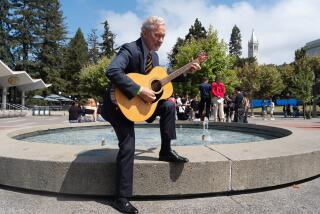City College of San Francisco to unveil blueprint for survival
SAN FRANCISCO — Officials at City College of San Francisco will unveil a tough blueprint for survival Thursday that will include an increased focus on moving students through the two-year school, a more centralized approach to finances and closing campuses.
The state’s largest community college prepared the detailed report in response to scathing findings by the Accrediting Commission for Community and Junior Colleges earlier this summer that placed its future in jeopardy. To emerge from the crisis, by next spring the college must justify its right to exist — an uncommon status known as “show cause” that falls one step shy of losing accreditation.
Among the litany of commission concerns: paltry financial reserves, a dearth of leadership and a slow-moving style of governance that has crippled accountability.
The blueprint for change, due to the commission by Oct. 15, comes after the interim chancellor of the 77-year-old campus joined with trustees, faculty, staff and student leaders over the last 90 days to prescribe bitter medicine.
The school has narrowed its mission statement from one that broadly stressed accessibility and affordability to instead prioritize students readying for transfer, seeking associate degrees or looking to build career and basic skills.
The point, City College spokesman Larry Kamer said, is to ensure that the institution won’t be “making promises that it could not keep.”
The school is changing the way it assesses its finances and the costs of operating its myriad campuses, and laying out plans to move away from a decision-making process known as “shared governance” to one that places more power in fewer hands.
The toughest proposals, however, will come down to specific financial cuts. Although those decisions must be made by trustees, the report lays out a host of possibilities. It recommends the immediate closure of one school in the city’s Castro neighborhood and of an administrative building that can be leased out for quick income. More facility closures are likely to follow.
About 92% of City College’s general fund goes to salaries and benefits, a level that accreditors called too high and out of sync with comparable institutions statewide. Furthermore, the reserve fund must be raised from 1% of general fund revenues to 5%, a shift that Kamer said “isn’t going to happen overnight.”
The school has prepared a balanced budget but it depends on the passage in November of Proposition 30, Gov. Jerry Brown’s proposed temporary tax increase. If that fails, City College will be facing an additional $11 million in cuts for the current year alone. The 90,000-student institution is hopeful that a local ballot measure will also pass, guaranteeing $14 million a year that can’t be touched by state budget cuts.
But even if both measures prevail, the school will face a deficit two years down the road without further hard choices, the report notes.
“The bottom line is that the College recognizes that clear, difficult choices must be made, immediately, and at a number of levels,” the report said.
Alisa Messer, president of the local chapter of the American Federation of Teachers, said the report demonstrates “the totality of folks pulling together and really working hard to meet the challenge,” and also marks the launch of painful budget cuts that seem to disproportionately affect faculty, staff and students.
Narrowing the college’s mission to tailor to shrinking revenues, for example, “seems entirely backwards,” Messer said. “It’s backwards for the whole state and all of public education right now.”
lee.romney@latimes.com
More to Read
Sign up for Essential California
The most important California stories and recommendations in your inbox every morning.
You may occasionally receive promotional content from the Los Angeles Times.











